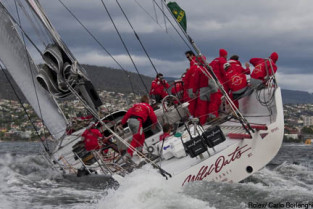The five boats have picked up fast speeds as they leave Japan behind them en route to New Zealand
The islands of southern Japan are now behind the Volvo Ocean fleet, as the five boats now plunge into the Pacific Ocean on their way southwards towards New Zealand – which must be left to starboard.
“The boat was practically flying,” said MCM Gustav Morin as Ericsson 3 took off in a 40-knot gust, reaching 36 knots of boat speed. “When you reach speeds like that, you know it isn’t going to last for long. King Neptune usually puts an enormous wave in front of the boat on occasions like that, just to see some action and make his everyday life, looking at a deserted sea, a bit more fun,” added Morin.
“It has been a tough 36 hours, with winds in the 20s and 30s (knots) and lots of pressed- up reaching. The decks have been awash and it has been survival suits, lifejackets and harnesses all round, day and night,” wrote Ian Walker from fourth placed Green Dragon.
The high-speed reaching conditions have been boosted by four-knots of the warm-water Kuroshio Current, also known as the Black Tide, but there is little chance of any passing lanes on this course of sailing. King Neptune has continued to amuse himself by testing the fleet in any way that he can. Thankfully, for now, the white water spray that is constantly dousing those on deck is relatively warm, due to the Black Tide, but that will change once the fleet is in the Southern Ocean in approximately 14 days time. The water temperature has risen from six degrees to just over 20 degrees centigrade in 24 hours.
 Ericsson 4 leads Puma by 16 nm. During the night, as the team passed Korea, they saw two Japanese boats fishing together. At 25 knots of boat speed, it was too late to alter course and the team sailed straight between the two, hoping that they were not connected. “Ten seconds later, we could breathe again and keep on going, looking for the next group,” explained trimmer, Horatio Carabelli/BRA.
Ericsson 4 leads Puma by 16 nm. During the night, as the team passed Korea, they saw two Japanese boats fishing together. At 25 knots of boat speed, it was too late to alter course and the team sailed straight between the two, hoping that they were not connected. “Ten seconds later, we could breathe again and keep on going, looking for the next group,” explained trimmer, Horatio Carabelli/BRA.
Puma has had some problems onboard including snapping a wheel in half when ploughing into the bottom of a big wave, and a mechanical issue with a steering quadrant. “A loss of about 15 miles over a couple of hours, but a small price to pay now that we have peace of mind that it is all fixed,” said skipper Kenny Read/USA/.
Overnight, Ericsson 3 passed Green Dragon and the other later starter – Telefónica Blue – is also making good progress. She is now just over 10 hours (197 nm) behind Ericsson 4. “We are staying honest with ourselves and sailing a course which we think is best for us – even if it is similar to the others,” explained Tom Addis, the navigator onboard Telefónica Blue for this leg. “Better and less risky opportunities will arise further down the track I am sure,” he added.



